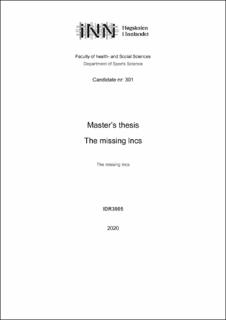The missing Incs
Master thesis
Permanent lenke
https://hdl.handle.net/11250/2723404Utgivelsesdato
2020Metadata
Vis full innførselSamlinger
Sammendrag
Introduction: Resistance training is volume dependent. The muscular adaptations to resistance training vary between moderate and low training volume. Little is known about how these muscular adaptions happen. LncRNAs have emerged as an interesting regulator of different signaling pathways connected to cell proliferation and growth. The aim of this study was to explore and identify differentially expressed lncRNAs in m. vastus lateralis, and thus, explore volume- and time-effects on muscular adaptations.
Method: Forty-one female and male participants were recruited to the study, of which 25 had biopsies, from all three timepoints, with sufficient RNA-quality. Strength tests and muscle biopsies were taken before, in the middle and after a 12week contralateral, within subject, resistance training intervention. Biopsies from the 25 participants were sent to RNA sequencing. RNA-seq data was analyzed with Mixed-effects negative binomial count models, and differential expression and log2fold-change was calculated on all three timepoints.
Results: Analysis of RNA-seq data identified 1400 lncRNAs, of which ~12% percent were differentially expressed (DE). Between timepoint w2pre and w12, 169 lncRNAs were differentially expressed. Most of the lncRNAs identified were upregulated, and 17 lncRNAs were DE at all three timepoints. No significant difference was found between low and moderate volume.
Conclusion
As many as17 DE lncRNAs were found on all three timepoints, suggesting that they are important in muscle adaptations to resistance training. Resistance training with low and moderate volume resulted in similar changes in lncRNA expression, reiterating on the fact that the different volume conditions to not lead to substantial differences in cellular phenotypes measured per unit muscle tissue (though higher volume is associated with larger increases in muscle mass). More research is needed to expand the entrezgene id database and allocate gene annotations.
Keywords
RNA-seq, qPCR, resistance training, long non-coding RNA, skeletal muscle.
